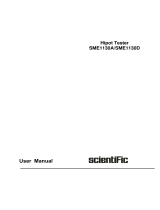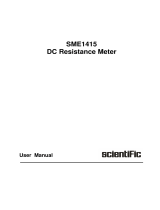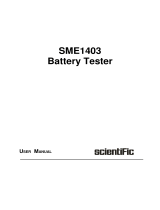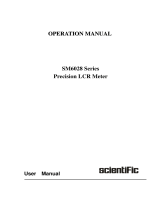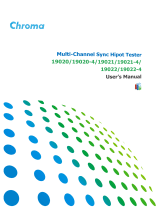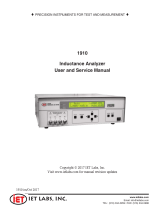Page is loading ...

AC/DC HIPOT TESTER
SME1110/SME1120
User Manual

Copyright © Scientific All rights reserved.
This instrument contains proprietary information, no part of this manual may be photocopied ,
reproduced or translated without any prior written consent.
Information in this manual supercede all corresponding previous released material.
Scientific continues to improve products and reserves rights to amend part or all of the
specifications , procedures, equipment at any time without notice.
Rev 1.2 / 0216

SME1110/SME1120 3
Content
Chapter 1 Setup.......................................................................................................... 6
1.1 Unpacking........................................................................................................... 6
1.2 Precautions for Use............................................................................................. 6
1.3 Precautions for Moving........................................................................................ 7
1.4 Checking Power Source and Fuse ...................................................................... 7
1.4.1 Power line voltage ...................................................................................... 7
1.4.2 Checking or replacing fuse ......................................................................... 7
1.5 Connecting the AC Power Cord .......................................................................... 8
1.6 Grounding ........................................................................................................... 8
1.7 Checking Operations........................................................................................... 8
1.8 Other Specifications............................................................................................ 9
Chapter 2 Precautions on Handling.......................................................................... 10
2.1 Prohibited Operations ......................................................................................... 10
2.2 Action When in Emergency................................................................................. 10
2.3 Precautions on Testing........................................................................................ 10
2.4 Warning for Residual High Voltages.................................................................... 11
2.5 Dangerous States of Failed Tester...................................................................... 12
2.6 To Ensure Long-Term Use without Failures ........................................................ 12
2.7 Daily Checking .................................................................................................... 13
Chapter 3 Part Names and Functions....................................................................... 14
3.1 Front Panel ......................................................................................................... 14
1. POWER........................................................................................................... 14
2. START and STOP ........................................................................................... 14
3. Make and Model .............................................................................................. 14
4. USB Interface .................................................................................................. 14
5. Indicator........................................................................................................... 14
6. FUNCTION...................................................................................................... 14
7. HV ................................................................................................................... 15
8. Output voltage HIGH terminal (HV).................................................................. 15
9. Test low terminal, test current return terminal (LOW/RET)............................... 15
10. Navigation keys ............................................................................................. 15
11. Function key .................................................................................................. 15
12. COPY key...................................................................................................... 15
13. LCD screen.................................................................................................... 15
3.2 Instruction of rear panel....................................................................................... 15
1. Fan.................................................................................................................. 15
2. Test low terminal, test current return terminal (optional) .................................. 16

4 SME1110/SME1120
3. High voltage output terminal (optional) ............................................................ 16
4. Power jack: with fuse holder, switchable line voltage mode............................. 16
5. Protective earth terminal.................................................................................. 16
6. Serial Number ................................................................................................. 16
7. RS232C serial interface................................................................................... 16
8. USB serial communication interface................................................................ 16
9. HANDLER interface......................................................................................... 16
10. SIGNAL interface .......................................................................................... 16
3.3 Multichannel Module Declaration......................................................................... 17
3.4 Description .......................................................................................................... 18
Chapter 4 Basic operation......................................................................................... 22
4.1 Interface structure overview ................................................................................ 22
4.2 Instruction of panel function interface and parameter.......................................... 23
4.2.1 SETUP ....................................................................................................... 24
4.2.2 TEST.......................................................................................................... 25
4.2.3 SYSTEM .................................................................................................... 26
4.2.4 FILE............................................................................................................ 28
4.3 Test item interface and parameter setup............................................................. 29
4.3.1 AC withstanding voltage test parameter setup............................................ 29
4.3.2 DC withstanding voltage test parameter setup............................................ 30
4.3.3 Insulation Resistance (IR) test parameter setup ......................................... 31
4.3.4 Open and short detection (OS) parameter setup ........................................ 32
4.3.5 MF (Multi channel follow)............................................................................ 33
4.3.6 CK (Multi channel contact check) ............................................................... 33
4.4 Test function theory and instruction..................................................................... 35
4.4.1 Start up test................................................................................................ 36
4.4.2 Test delay................................................................................................... 36
4.4.3 Test voltage rise ......................................................................................... 36
4.4.4 DC RAMP................................................................................................... 36
4.4.5 High-voltage test......................................................................................... 36
4.4.6 Voltage fall.................................................................................................. 36
4.4.7 Ground wire current detection function ....................................................... 36
4.4.8 Current over limit and arc detection (ARC) function.................................... 37
4.4.9 Fail judgment.............................................................................................. 38
4.4.10 Deal with test results ................................................................................ 38
4.4.11 STOP ....................................................................................................... 38
4.4.12 OFFSET ................................................................................................... 38
4.5 SCAN multi-channel strudture and use ............................................................... 39
4.5.1 SCAN parameter ........................................................................................ 39

SME1110/SME1120 5
4.5.2 Structure Principle ...................................................................................... 39
4.6 Structure and Use of HANDLER and SIGNAL Interface Circuit ........................... 40
4.6.1 Control interface theory............................................................................... 40
4.6.2 Control interface instruction ........................................................................ 41
4.7 Other interface and function ................................................................................ 41
Chapter 5 Serial port commands instruction ........................................................... 42
5.1 SCPI commands........................................................................................... 42
5.2 DISPlay Subsystem Commands................................................................... 42
5.3 FUNCtion Subsystem Commands ................................................................ 43
5.4 FETCh Subsystem Commands..................................................................... 57
5.5 SYSTem Subsystem Commands.................................................................. 57
5.6 Other Commands .......................................................................................... 61
Maintenance ............................................................................................................... 62

6 SME1110/SME1120
Chapter 1 Setup
1.1 Unpacking
Upon receiving the product, confirm that the necessary accessories are included and
have not been damaged in transit. Should any damage or shortage be found, please
contact our distributor/agent.
Items Quantity
SME1110/SME1120 1
90003R withstanding-voltage test lead-wires 1
90003B withstanding-voltage ground lead-wires 1
AC Power cord 1
Operation Manual CD 1
Accessories ordered by customers -
1.2 Precautions for Use
Please read following instructions before using the tester.
Do not use the tester in a flammable atmosphere.
To prevent explosion or fire, do not use the tester near alcohol, thinner, or other
combustible materials, or in an atmosphere containing such vapors.
Avoid locations where the tester is exposed to high temperatures or direct
sunlight.
Do not locate the tester near a heater or in areas subject to drastic temperature changes.
Operating temperature range: 5 °C to +35 °C
Storage temperature range: -20 °C to +60 °C
Avoid humid environments.
Do not locate the tester in a high-humidity environment—near a boiler, humidifier or
water supply. Operating humidity range: 20% to 80% RH (no dew condensation
permitted)
Storage humidity range: 90%RH or less (no dew condensation permitted)
Condensation may occur even within the operating humidity range. In that case, do not
start using the tester until the location is completely dry.
Do not place the tester in a corrosive atmosphere.
Do not install the tester in a corrosive atmosphere or one containing sulfuric acid mist or
the like. This may cause corrosion of various conductors and imperfect contact with
connectors, leading to malfunction and failure, or in the worst case, a fire.
Do not locate the tester in a dusty environment.
Dirt and dust in the tester may cause electrical shock or fire.
Do not use the tester where ventilation is poor.
This tester features a forced-air cooling system. Provide sufficient space for the air inlet
on the lateral side and the air outlet on the rear side to allow air to flow.

SME1110/SME1120 7
Do not place the tester on a tilted surface or in a location subject to vibrations.
If placed on a non-level surface or in a location subject to vibration, the tester may fall,
resulting in damage and injury.
Do not use the tester in locations affected by strong magnetic or electric fields.
Operation in a location subject to magnetic or electric fields may cause the tester to
malfunction, resulting in electrical shock or fire.
Do not use the tester in locations near a sensitive measuring instrument or
receiver.
Operation in a location subject, may cause such equipment may be affected by noise
generated by the tester.
At a test voltage exceeding 3 kV, corona discharge may be generated to produce
substantial amounts of RF broadband emissions between grips on the test lead wire. To
minimize this effect, secure a sufficient distance between alligator clips. In addition, keep
the alligator clips and test lead wire away from the surfaces of conductors (particularly
sharp metal ends).
1.3 Precautions for Moving
When moving the tester to the installation site or otherwise transporting it, take the
following precautions:
Before moving the tester, turn off the power switch.
Transporting the tester with its POWER switch on can lead to electric shock and
damage.
When moving the tester, Disconnect all wires from it.
Moving the tester without disconnecting the cables may result in breakage of the wire or
injury due to the tester tipping over.
1.4 Checking Power Source and Fuse
1.4.1 Power line voltage
WARNING: This instrument is designed to operate for the over voltage category II. Do
not operate it from the over voltage category III or IV.
Before turning on the power, make sure to identify fuse and the source voltage
Allowable voltage range : 220V ± 10% AC(i.e. 198V to 242V AC)
Allowable frequency range : 47 Hz to 63 Hz
1.4.2 Checking or replacing fuse
WARNING To prevent electric shock, before checking or replacing the fuse, be sure to turn
off the POWER switch and unplug the AC power cord.
Make sure that the fuse used conforms to the instrument specifications, including shape,
rating, and characteristics. Using a fuse with different rating or short-circuiting the fuse holder
will damage the instrument.
1. Turn off the POWER switch, and unplug the AC power cord.
2. On the rear panel, remove the fuse holder, by pushing it inward .
3. The fuse holder has the feature of switching the power input range and it shall reveal the
POWER mark on the outer shell.
4. Check the fuse type and choose the fuse according to the following table. The fuse is
time lag fuse.
5. Reinstall the fuse holder.

8 SME1110/SME1120
1.5 Connecting the AC Power Cord
1. Confirm that the supply voltage is within the line voltage range of the tester.
2. Confirm the nominal value of the fuse and the line power are correctly selected.
3. Confirm that the POWER switch on the tester is off.
4. Connect the AC power cord to the AC LINE connector on the rear panel.
1.6 Grounding
WARNING: Be sure to connect the tester to an electrical ground (safety ground). If the
output to a conveyer or peripheral device that is connected to an earth ground or a
nearby commercial power line is short-circuited without grounding, the tester chassis is
charged to an excessively high voltage, resulting in extreme danger.
This tester is designed as a ClassⅡ equipment (equipment protected against electric
shock with protective grounding in addition to basic insulation). Therefore, electric shock
may occur without proper grounding.
To ensure safety, be sure to ground the tester.
Choose either of the following two available methods of doing so:
1. Connect the AC power cord to a three-contact grounded electrical outlet.
2. Connect the protective conductor terminal on the rear panel to the earth ground.
To ensure secure connection, slect standard cable and use proper tools.
Earth
1.7 Checking Operations
WARNING: Use the interlock jumper only to quickly cancel the protection status.
When using this tester in a cramped working space, make a box-like structure for the
DUT; when testing a complicated large-scale DUT, provide a cover or other means for
the DUT to prevent electric shock by cutting off the output when the cover is opened. It is
also recommended that an enclosure be provided around the operating area and that
output be cut off every time the door is opened.
Before turning on the power, confirm that the allowable voltage range indicated on the
power supply is the same as that indicated on the rear panel of the tester.
When the power is turned on, the tester lights all LEDs on the front panel and self-
diagnosis is started. Before starting up the tester, confirm that all LEDs are on to
ensure safety.
It is particularly dangerous to start a test when the DANGER lamp is broken.

SME1110/SME1120 9
Note that, in self-diagnosis, even when the DANGER lamp is lighting, no output or
voltage is being generated.
CAUTION: After turning off the POWER switch, wait several seconds before turning it
on. Turning the POWER switch on/off repeatedly with insufficient intervals may damage
the tester.
Checking procedure:
1. Confirm that the allowable voltage range indicated on the power supply is the same as
the input voltage range set by the fuse holder.
2. Confirm that the AC power cord is properly connected to the AC LINE connector on
the rear panel.
3. Plug in the AC power cord.
4. Turn on the POWER switch. Confirm that all LEDs on the front panel are lit. Following
the opening screen, display the ACW screen.
5. Following the opening screen, display the ACW screen and confirm that the tester is
kept in the READY status.
6. Turn on the POWER switch again.
1.8 Other Specifications
1. Power : ≤400VA (SME1110/A/B)
: ≤ 500VA (SME1120/A/B)
2. Dimensions(W*H*D): 340mm*120mm*450mm;
3. Weight : approx. 13kg (SME1110/A/B)
: approx. 15kg (SME1120/A/B)
Multi-channel module :
4. Dimensions(W*H*D): 340mm*50mm*450mm;
5. Weight : approx. 5kg

10 SME1110/SME1120
Chapter 2 Precautions on Handling
This chapter describes the precautions to be followed in the handling of this tester.
When using the tester, take utmost care to ensure safety.
WARNING :The tester derivers a 5 kV test voltage which can cause human injury
or death. When operating the tester, be extremely careful and observe the
cautions, warnings, and other instructions given in this chapter.
2.1 Prohibited Operations
Do not turn on/off the power repeatedly
After turning OFF the power switch, be sure to allow several seconds or more before
turning it ON again. Do not repeat turning ON/OFF the power switch rapidly. If you do
this, the protectors of the tester may not be able to render their protective functions
properly. Do not turn OFF the power switch when the tester is delivering its test voltage–
you may do this only in case of emergency.
Do not short the output to the earth ground
Pay attention so that the high test voltage line is not shorted to a nearby AC line or
nearby devices (such as conveyors) which are connected to an earth ground. If it is
shorted, the tester chassis can be charged up to the hazardous high voltage. Be sure to
connect the protective grounding terminal of the tester to an earth line. If this has been
securely done, even when the HIGH VOLTAGE terminal is shorted to the LOW terminal,
the tester will not be damaged and its chassis will not be charged up to the high voltage.
Be sure to use a dedicated tool when grounding the protective grounding terminal.
CAUTION: The term "AC line" here means the line on which the tester is operating. That
is the line to whose outlet the AC power cable of the tester is connected. It may be of a
commercial AC power line or of a private-generator AC power line.
Do not apply an External Voltage
Do not apply a voltage from any external device to the output terminals of the tester. The
voltmeter on the front panel cannot be used as stand-alone voltmeter. They may be
damaged if their output terminals are subject to an external voltage.
2.2 Action When in Emergency
In case of an emergency (such as electric shock hazard or burning of DUT), take the
following actions. You may do either (a) or (b) first. But be sure to do both.
1. Turn OFF the power switch of the tester.
2. Disconnect the AC power cord of the tester from the AC line receptacle.
2.3 Precautions on Testing
• Wearing Insulation Gloves
When handling the tester, be sure to wear insulation gloves in order to protect yourself
against high voltages.
• Precautions for Pausing Tests
When changing test conditions, press the STOP switch once to take precautions. If you
are not going to resume the test soon or if you are leaving the Test area, be sure to
turn-OFF the POWER switch.

SME1110/SME1120 11
• Items Charged Up to Dangerous High Voltages
When in test, the HV output, HV test leads, HV probes, DUT and output terminals and
their vicinities can be charged up to dangerous high voltages. Never touch them when in
test.
WARNING: The vinyl sheaths of the alligator clips of the test lead-wires which are
supplied accompanying the tester have no sufficient insulation for the high test voltages.
Never touch them when in test.
• Matters to be Sure of After Turning-OFF Power
If you have to touch the DUT, test lead-wires, probes, and/or output terminals and their
vicinities for re-connections or other reasons, be sure of the following two matters.
1. To confirm that the working condition is not in test mode.
2. The DANGER lamp has gone out.
• Warnings for Remote Control
Be extremely careful when operating the tester in the remote control mode in which the
dangerous high test voltage is ON/OFF-controlled remotely. The operator cannot know
the real working condition of the instrument through the interface. Please pay special
attention to check the reliable connection of the remote control:
1. The “STOP” switch must be connected reliably. Press the “STOP” switch before
changing the DUT.
2. When testing in a working environment with a lot of people, remote control
switch has the
“INTLOCK”switch and HV lamp. Disconnect the “INTLOCK” switch before changing
the DUT.
Provide means to assure that none can touch the DUT, test leadwires, probes, output
terminals and their vicinities when the test voltage is being delivered.
2.4 Warning for Residual High Voltages
WARNING: In DC withstanding voltage testing and insulation resistance testing, the test
lead wire, test probe, and DUT are charged to a high voltage. The tester is equipped
with a discharge circuit, but some time is nonetheless required to discharge them after
the output is cut off. There is a danger of electric shock during discharge. To avoid
electric shock, take the utmost care to ensure that the DUT, test lead wire, probe, and
highly charged parts around the output terminal are not touched. If it is necessary to
touch them, be sure to confirm the DANGER lamp has gone out.
As soon as the output is cut off, the tester’s discharge circuit starts forced discharging.
Do not disconnect the DUT during a test or prior to completion of discharging.
Under normal circumstances, it can be guaranteed that the test loop voltage is within the
safe voltage range when finishing discharging. When the capacitance of the DUT is too
large or the structure of the DUT is special, it may leads to incomplete discharge. In
order to ensure complete discharge, test method must be changed by technical
personnel.
Discharge time:
Computational formula of discharge time: t = -ln(30 / U)×R×C
t: discharge time
30: discharge residue safty voltage 30V

12 SME1110/SME1120
U: test set voltage
R: discharge impedance of the DUT, the discharge impedance of the instrument is
approx. 10k
C: capacitance of the DUT
In general, only DC high voltage test needs discharge and the length of the discharge
time varies according to the properties of the DUT.
If the test terminated normally, the voltage will drop to zero according to the voltage fall
time. If the test failed, discharge of the DUT is conducted by the transformer secondary
winding(resistance of approximately 10k). Approximately 0.05s are required for 1uF
capacitor with high voltage of 6000V to discharge to 30V. The fixed discharge time of
the instrument is 0.2s, which ensures complete discharge of the device.
2.5 Dangerous States of Failed Tester
Typical possible dangerous states of the tester are as shown below and in which cases
the most dangerous situation that “the high test voltage remains delivered and the
instrument get out of control” may occur. When this situation has occurred,
1. Immediately turn OFF the power switch and disconnect the AC power cable from the
AC line receptacle.
2. Immediately keep far away from the instrument and confirm no risk of the test circuit
by the technical personnel; or keep the instrument still for more than one hour and
confirm no output voltage in the test terminal.
3. Remove the relevant connecting lines and send the instrument back to us for
maintenance.
WARNING: Keep away from the instrument after turning off the power and prevent
other people from approaching. Do not immediately disassemble the test circuit.
Immediately call our distributor or agent. High voltage may remain in the interior of the
instrument. It is hazardous for an unqualified person to attempt to troubleshoot any
tester problem.
2.6 To Ensure Long-Term Use without Failures
The withstanding voltage-generating block of the tester is designed to release half the
rated amount of heat, in consideration of the size, weight, cost, and other factors of the
tester. The tester must therefore be used within the ranges specified below. If you
deviate from these ranges, the output block may be heated to excess, activating the
internal protection circuit. Should this happen, wait until the temperature returns to the
normal level.
Output requirements for withstanding voltage testing
Ambient
temperature
Upper Current Pause Time Output Time
>12mA (SME1120/A/B)
>6mA (SME1110/A/B)
At least as long as
the output time
Maximum of 1
minute
AC <8mA (SME1120/A/B)
<4mA (SME1110/A/B) Not necessary Continuous
output possible
>6mA (SME1120/A)
>3mA (SME1110/A)
At least as long as
the output time
Maximum of 1
minute
T≤ 40°C
DC <4mA (SME1120/A)
<2mA (SME1110/A)
At least as long as
the charging wait
time (WAIT TIME)
Continuous
output possible

SME1110/SME1120 13
2.7 Daily Checking
To avoid accidents, confirm at least the following before starting operation:
1. The input source complies with the standard and the tester power configuration is
correct.
2. The tester is connected to an earth ground.
3. The coating of the high-voltage test lead wire is free from cracks, fissures, and
breakage.
4. Without connecting the test lines, the instrument can finish the test successfully when
starting test by default.
5. The tester generates FAIL signal when the ends of the low-voltage test lead wire and
high-voltage test lead wire are short-circuited.

14 SME1110/SME1120
Chapter 3 Part Names and Functions
This chapter describes the names and functions of components such as switches, displays,
and connectors on the front and rear panels.
3.1 Front Panel
Figure 3-1 gives a brief description of the front panel for SME1110/SME1120 series
Figure 3-1
1. POWER
Power switch.
2. START and STOP
START (square): Start up the instrument, once test starts, “TEST” will be
displayed at the left corner of the screen, TEST indicator lights.
STOP (circle): Stop key, used to cancel the test, or PASS, FAIL status.
3. Make and Model
Make and model number information
4. USB Interface
Externally connect to USB storage.
5. Indicator
• FAIL
When the test data exceeds the set data in test, the instrument will lights in FAIL.
● PASS
When the test data does not exceed the set data after the test, the instrument will
lights in PASS.
When time function is off (TIMER OFF), there is no PASS judge. The test can be
finished only by pressing the ‘STOP’ key.
6. FUNCTION
Select mode, system and interface.

SME1110/SME1120 15
● TEST
Press the key and the corresponding key lights; the instrument is ready to test.
● SETUP
Press the key and the corresponding key lights, the instrument enters parameter
setting;
● SYSTEM
Press the key and the corresponding key lights, the system setting interface will be
displayed;
● FILE
Press the key and the corresponding key lights, the file operation interface will be
displayed;
7. HV
DANGER!!It lights in test, indicating the test is underway.
8. Output voltage HIGH terminal (HV)
High voltage output of the high voltage test interface.
9. Test low terminal, test current return terminal (LOW/RET)
Voltage output terminal and current sampling terminal of the test.
10. Navigation keys
It is used for moving cursor on the screen.
11. Function Keys
F1-F5, corresponding with the function operation area on the right of the LCD.
12. COPY key
COPY key can copy the screen pictures to the USB storage. The USB starage
should be inserted into the USB jack on the front panel in advance.
13. LCD screen
480*272 TFT dot- matrix LCD screen, display setting and test interface, etc.
3.2 Instruction of rear panel
Figure 3-2 gives a brief description of the front panel for SME1104-1/SME1105-1.
1 2
3
4
5
HV OUTPUT
RTN/LOW
HIGH VOLTAGE
MAX:5kV AC
! WARNING:FOR CONTINUED PROTECTION AGAINST FIRE HAZARD,
REPLACE ONLY WITH THE SAME TYPE AND RATING OF FUSE AS
SPECIFIED FOR THE LINE VOLTAGE BEING UTILIZED.
110V/220V~50/60Hz
! CAUTION:NO OPERATOR SERVICEABLE PARTS INSIDE
REFER SERVICING TO QUALITIFIED PERSONNEL.
HANDLE
RS-232C
USB
SIGNAL
10
9
8 7
6
Figure 3-2
1. Fan

16 SME1110/SME1120
Forced air cooling for heat dissipation.
2. Test low terminal, test current return terminal (optional)
Stand-by test low terminal of high voltage test interface.
3. High voltage output terminal (optional)
Stand-by high voltage output terminal of high voltage test interface.
4. Power jack: with fuse holder, switchable line voltage mode
Be used to input AC power. Please use the voltage within the specified input
voltage range and please use the attached power line with fuse. Change the fuse
according to input power.
Please choose different installation position according to different input power
type. Please pay attention to the visible identification on the outer shell of the fuse
holder when installing.
5. Protective earth terminal
Be used to connect instrument to ground.
NOTE: The three-pin power jack of the instrument can not guarantee
reliable connection to the ground. The protective earth terminal must be
used to connect the instrument to grounding bar.
6. Serial Number
This mark indicates the serial number of the instrument.
7. RS232C serial interface
Serial communication, realize the communication with the computer.
8. USB serial communication interface
Realize the communication with the computer. Through this interface, the
computer can control the instrument by using the control instruction set.
9. HANDLER interface
Compared to PLC interface, the HANDLER interface has no INTERLOCK
function in interface signal. It is more convenient than PLC interface to use 9 core
model D jack to output. It is appropriate for the connection of general control
circuit for multiple instruments.
TEST:Output synchronized-signal control when high voltage output is started.
START:Input the starting signal for starting high voltage output, corresponding
to START signal on the front panel.
RESET:Input the reset signal for stopping high voltage output, corresponding to
STOP signal on the front panel.
PASS:The output pass signal of the instrument, corresponding to PASS
instruction on the front panel.
FAIL:The output fail signal of the instrument, corresponding to FAIL
instruction on the front panel.
10. SIGNAL interface
It is the interface for online protection and interior 24V power output.
INTERLOCK:(COM(5) S+ -- (6) COM) valid in SHORT. It is the online locking
signal of the instrument, if off, starting output is not allowed.
DC 24V Power: (COM(1,2) 24V – (3,4) GND). It is used for requirement of
indicator light and other control power supply.

SME1110/SME1120 17
3.3 Multichannel module declaration
Multi-channel Output is an internal high-voltage switching module attached at the bottom
of the instrument.
Through multi-channel output module, multiple test points of the components can be
connected with multiple channels at a time. During testing, the instrument can be set to
control the channel switch. Controllable testing can be achieved by connecting the
corresponding port to withstand voltage test terminal.
With this multi-channel module, rapid connection can be achieved through test fixture
without changing ports during the testing process.
The test connection diagram is as follows:
3.3 Description
SME1120 : Provide 5kV AC/20mA, 6kV DC/10mA withstanding voltage and insulation
resistance test.
SME1120A : Provide 5kV AC/20mA, 6kV DC/10mA withstanding voltage test.
SME1120B : Provide 5kV AC/20mA withstanding voltage test.
SME1120-4 : Provide 5kV AC/20mA, 6kV DC/10mA withstanding voltage and insulation
resistance test (4 Channel)
SME1120-8 : Provide 5kV AC/20mA, 6kV DC/10mA withstanding voltage and insulation
resistance test (8 Channel)
SME1110 : Provide 5kV AC/10mA, 6kV DC/5mA withstanding voltage and insulation
resistance test.
SME1110A : Provide 5kV AC/10mA, 6kV DC/5mA withstanding voltage test.
SME1110B : Provide 5kV AC/10mA withstanding voltage test.

18 SME1110/SME1120
The principle structure of the instrument: In high voltage module, there is a DA
standard, controllable forcing function generator, AB power amplifier, 40~600Hz high
voltage boost transformer and output voltage closed-loop control.
DA standard: ensure controllable output voltage amplitude.
Controllable forcing function generator: In AC output, set the operation in 50 or
60Hz,not being limited by line voltage.
Linear power amplifier: low distortion of the voltage waveform with easy control and high
reliability.
40~600Hz high voltage boost transformer: the test instrument uses 600Hz AC to form
DC voltage to be the power, which can assure the DC power ripple is far less than the
formal withstanding voltage tester.
Output voltage closed-loop control: ensure small load regulation and reliable test data.
Software of the instrument: multiparameter continuous test and multiple upper
computer control function.
SME1110/20 series not only can perform the independent AC withstanding test, DC
withstanding voltage test, insulation resistance test, but also multi-item test via the
setting of test program.
SME1110/20 series all allocate HANDLER, RS-232C and USB, thus the instrument can
adapt to the auto test system of different required safety and reliability.
Software of the instrument:
The instruments allocate HANDLER, RS-232C and USB, thus the instrument can adapt
to the auto test system of different required safety and reliability.
Feature:
■ 4 test functions—AC withstanding voltage test, DC withstanding voltage test,
Insulation Resistance Test, open and short detection.
SME1110, SME1120 provide AC/DC withstanding voltage test and insulation resistance
test.
SME1110A, SME1120A provide AC/DC withstanding voltage test.
SME1110B, SME1120B provide AC withstanding voltage test.
All the instruments have the open and short detection function.
Once connected with load, the tester can perform different tests continually.
■ 2 different test power selection
In SME1120 series high voltage module, there is a AB power amplifier circuit and a
100VA high voltage transformer, which can realize the output of 5kV/20mA and the
output of 5kV/10mA (DC).
The distortion of the waveform is less than 3%.
In SME1110 series high voltage module, there is a AB power amplifier circuit and a
50VA high voltage transformer, which can realize the output of 5kV/10mA and the output
of 5kV/5mA (DC).
The distortion of the waveform is less than 3%.
If continuous current output is set, in order to guarantee the reliability of the instrument,
the maximum output time is 60 seconds when the output is more than 60% of the rated
output current. If the output is within 60%~40% of the rated output current, the
continuous working hours should be limited. If the output is less than 40% of the rated
output current, it can ensure continuous working.

SME1110/SME1120 19
Figure 3-3 AC voltage load regulation
■ DC withstanding voltage test 5kV/10mA (SME1120/A) 5kV/5mA(SME1110/A)
The SME1110/20/A can provide DC withstanding voltage test of wide voltage range
(Max. output DC is 6kV). The automatic voltage regulation and voltage load regulation of
600Hz frequency hardware is less than 1%+10V.
Figure 3-4 SME1120/A DC voltage output range
■ Insulation resistance test 0.050kV to 1.000kV(
((
(resolution of 1V)
))
)/0.1MΩ to
10.0GΩ
(Max. rated current of SME1120 is 10mA and max. rated current of SME1110 is
5mA)
Insulation resistance test range:
When the voltage is less than 500V: 0.1MΩ to 1GΩ with accuracy of ±[10% reading
+5digits].
When the voltage is greater than 500V: 0.1MΩ to 100MΩ with accuracy of [5%
reading +5 digits], 100MΩ to 1GΩ with accuracy of [10% reading +5 digits].

20 SME1110/SME1120
■ Open and short detection: judge the reliability of the DUT before starting the high
voltage to ensure the accuracy and safety of high voltage test.
Open and short detection can judge the distribution impedance current of more than
100pF. When the current is less than this value, the current acquisition circuit resolution
of the instrument can not distinguish the connection of open circuit and the test
component accurately.
■ RS-232C interface as the standard
Except power switch, key lock and execution (auto), other functions can be controlled
remotely. In DC and AC withstanding voltage test and insulation resistance test, judge
and time can be controlled remotely. The test result can also be read via remote control.
USB and RS-232C interface provides a stable and united standard test interface for PC
or other devices.
■ HANDLER and SIGNAL interfaces bring convenience for the connection and
control.
HANDLER interface can input START and STOP signals and output TEST, PASS and
FAIL signals. Connecting with a footswitch, they can construct a foot-control device;
while connecting with simple test fixtures, they can realize safety interlock, air controls,
test indication, etc.
SIGNAL interface can input INTERLOCK signal and provide 24V, 1A power output. It is
convenient for control and connection.
■ USB interface for backup
Through the USB interface equipped by all testers, tester programmed test programmes
and customer’s measuring file can be saved to or recalled from an external U disk, which
is convenient to set, use and file a batch of testers.
■ Waiting time setup function
The instrument can set the test waiting time from 0.1s to 999.9s by a resolution of 0.1s. In
this period, the tester will output TEST control signals. They are used to control external
devices and ensure a reliable connection. After that high voltage measurement will be
enabled.
■ Rising time control function
In AC withstanding voltage test, DC withstanding voltage test and insulation resistance
test, the test voltage can be raised to set value slowly, it can’t provide set voltage to DUT
instantly after test starts. The voltage rise time is from 0.1s to 999.9s and the resolution is
0.1s. The SME1110/SME1120 meet each UL test standard and IEC withstanding voltage
standard(primary voltage is less than the half of test voltage and it can appoint the fixed
rising time when reaching the set test voltage.
■ Fall time control function
In the pass judge of AC withstanding voltage test, the test voltage can be reduced
gradually. The voltage fall time can be set within 0.1s to 999.9s (with the resolution of
0.1s).
■ Discharge function
In common condition, the DUT reacts the feature of capacitance. At the moment of the
cut of DC withstanding voltage and insulation resistance test, the DUT holds the full
charge status, so there is a danger of electric shock. The SME1110/SME1120 has the
/
